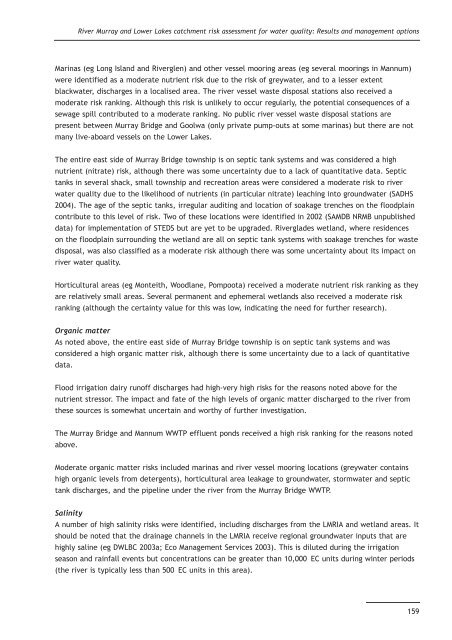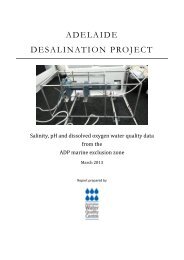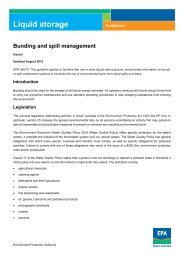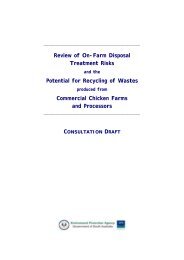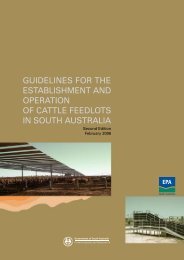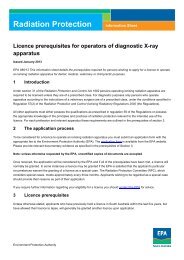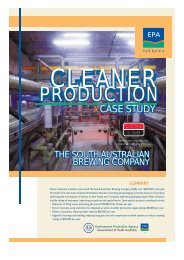2 Renmark to border LAP area assessment - EPA - Sa.gov.au
2 Renmark to border LAP area assessment - EPA - Sa.gov.au
2 Renmark to border LAP area assessment - EPA - Sa.gov.au
You also want an ePaper? Increase the reach of your titles
YUMPU automatically turns print PDFs into web optimized ePapers that Google loves.
River Murray and Lower Lakes catchment risk <strong>assessment</strong> for water quality: Results and management options<br />
Marinas (eg Long Island and Riverglen) and other vessel mooring <strong>area</strong>s (eg several moorings in Mannum)<br />
were identified as a moderate nutrient risk due <strong>to</strong> the risk of greywater, and <strong>to</strong> a lesser extent<br />
blackwater, discharges in a localised <strong>area</strong>. The river vessel waste disposal stations also received a<br />
moderate risk ranking. Although this risk is unlikely <strong>to</strong> occur regularly, the potential consequences of a<br />
sewage spill contributed <strong>to</strong> a moderate ranking. No public river vessel waste disposal stations are<br />
present between Murray Bridge and Goolwa (only private pump-outs at some marinas) but there are not<br />
many live-aboard vessels on the Lower Lakes.<br />
The entire east side of Murray Bridge <strong>to</strong>wnship is on septic tank systems and was considered a high<br />
nutrient (nitrate) risk, although there was some uncertainty due <strong>to</strong> a lack of quantitative data. Septic<br />
tanks in several shack, small <strong>to</strong>wnship and recreation <strong>area</strong>s were considered a moderate risk <strong>to</strong> river<br />
water quality due <strong>to</strong> the likelihood of nutrients (in particular nitrate) leaching in<strong>to</strong> groundwater (SADHS<br />
2004). The age of the septic tanks, irregular <strong>au</strong>diting and location of soakage trenches on the floodplain<br />
contribute <strong>to</strong> this level of risk. Two of these locations were identified in 2002 (SAMDB NRMB unpublished<br />
data) for implementation of STEDS but are yet <strong>to</strong> be upgraded. Riverglades wetland, where residences<br />
on the floodplain surrounding the wetland are all on septic tank systems with soakage trenches for waste<br />
disposal, was also classified as a moderate risk although there was some uncertainty about its impact on<br />
river water quality.<br />
Horticultural <strong>area</strong>s (eg Monteith, Woodlane, Pompoota) received a moderate nutrient risk ranking as they<br />
are relatively small <strong>area</strong>s. Several permanent and ephemeral wetlands also received a moderate risk<br />
ranking (although the certainty value for this was low, indicating the need for further research).<br />
Organic matter<br />
As noted above, the entire east side of Murray Bridge <strong>to</strong>wnship is on septic tank systems and was<br />
considered a high organic matter risk, although there is some uncertainty due <strong>to</strong> a lack of quantitative<br />
data.<br />
Flood irrigation dairy runoff discharges had high-very high risks for the reasons noted above for the<br />
nutrient stressor. The impact and fate of the high levels of organic matter discharged <strong>to</strong> the river from<br />
these sources is somewhat uncertain and worthy of further investigation.<br />
The Murray Bridge and Mannum WWTP effluent ponds received a high risk ranking for the reasons noted<br />
above.<br />
Moderate organic matter risks included marinas and river vessel mooring locations (greywater contains<br />
high organic levels from detergents), horticultural <strong>area</strong> leakage <strong>to</strong> groundwater, s<strong>to</strong>rmwater and septic<br />
tank discharges, and the pipeline under the river from the Murray Bridge WWTP.<br />
<strong>Sa</strong>linity<br />
A number of high salinity risks were identified, including discharges from the LMRIA and wetland <strong>area</strong>s. It<br />
should be noted that the drainage channels in the LMRIA receive regional groundwater inputs that are<br />
highly saline (eg DWLBC 2003a; Eco Management Services 2003). This is diluted during the irrigation<br />
season and rainfall events but concentrations can be greater than 10,000 EC units during winter periods<br />
(the river is typically less than 500 EC units in this <strong>area</strong>).<br />
159


